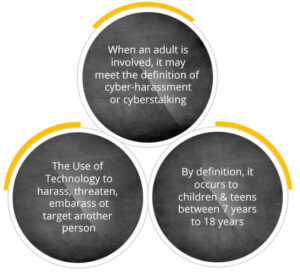INTRODUCTION
Cyberbullying is a pervasive form of harassment and abuse that occurs through digital communication channels, such as social media, messaging apps, emails, and online forums. It encompasses various behaviors aimed at intimidating, humiliating, or threatening individuals, often with the intention of causing harm or distress. Online harassment and cyberstalking are two prevalent manifestations of cyberbullying, each presenting distinct challenges and impacts on victims and society. In this comprehensive analysis, we’ll delve into the complexities of cyberbullying, examining its characteristics, effects, prevention strategies, and legal implications.

1. Online Harassment: Online harassment involves the repeated or targeted harassment, intimidation, or abuse of individuals through digital communication platforms. It can take various forms, including derogatory comments, insults, threats, defamation, doxxing (revealing personal information), and impersonation.
2. Characteristics of Online Harassment:
- Perpetrators of online harassment may be anonymous or known individuals, including acquaintances, peers, classmates, colleagues, or strangers.
- Online harassment often targets individuals based on their gender, race, ethnicity, sexual orientation, religion, disability, or other personal characteristics, exacerbating systemic discrimination and inequalities.
- Harassment may occur in public forums, social media platforms, gaming communities, or private messages, creating a pervasive and intrusive environment for victims.

3. Impacts of Online Harassment:
- Online harassment can have profound psychological, emotional, and social effects on victims, leading to anxiety, depression, stress, low self-esteem, and suicidal ideation.
- Victims of online harassment may experience social isolation, withdrawal from online and offline activities, and disruptions in personal relationships, academic or professional pursuits.
- Online harassment can create a hostile and toxic online environment, undermining digital citizenship, community trust, and free expression.
4. Cyberstalking: Cyberstalking involves the persistent, unwanted pursuit, monitoring, or surveillance of individuals through online means, often with the intention of instilling fear, control, or harm. It may include repeated messages, threats, surveillance, stalking behaviors, and unwanted contact.
5. Characteristics of Cyberstalking:
- Cyberstalkers may be former partners, acquaintances, strangers, or individuals with obsessive or delusional tendencies, seeking to exert power and control over their victims.
- Cyberstalking behaviors may escalate over time, with perpetrators using technology to track victims’ movements, monitor their online activities, and invade their privacy.
- Cyberstalking can extend to offline harassment, physical stalking, and real-world threats, posing serious risks to victims’ safety and well-being.
6. Impacts of Cyberstalking:
- Cyberstalking victims experience heightened levels of fear, anxiety, and trauma, as they are subjected to constant surveillance, intrusion, and threats.
- Cyberstalking can disrupt victims’ daily lives, personal relationships, and sense of security, leading to social isolation, hyper-vigilance, and emotional distress.
- Victims may suffer physical harm, harassment, or violence from cyberstalkers who escalate their behaviors from online harassment to offline stalking and harassment.

7. Prevention and Intervention Strategies:
- Preventing cyberbullying requires a multi-faceted approach that addresses root causes, promotes digital literacy, fosters empathy and respect, and empowers bystanders to intervene.
- Educational initiatives, awareness campaigns, and school-based programs can teach students, parents, and educators about online safety, responsible digital citizenship, and strategies for responding to cyberbullying.
- Law enforcement agencies, social media platforms, and tech companies play a crucial role in combating cyberbullying by enforcing policies, improving reporting mechanisms, and implementing technological safeguards to prevent abuse and harassment.
8. Legal Implications:
- Cyberbullying and cyberstalking may violate laws and regulations related to harassment, stalking, defamation, privacy, and digital abuse in many jurisdictions.
- Legal remedies for cyberbullying victims may include civil lawsuits, restraining orders, criminal prosecution, and regulatory actions against perpetrators, depending on the severity and impact of the harassment.
- Legislation and policy reforms are needed to address gaps in legal frameworks, enhance protections for victims, and hold perpetrators of cyberbullying and cyberstalking accountable for their actions.
In conclusion, cyberbullying, including online harassment and cyberstalking, represents a serious threat to individuals’ safety, well-being, and digital rights. Addressing cyberbullying requires collaborative efforts from government agencies, law enforcement, educators, tech companies, and civil society to promote online safety, protect victims, and hold perpetrators accountable. By fostering a culture of respect, empathy, and responsibility in digital spaces, stakeholders can create a safer and more inclusive online environment for everyone.

